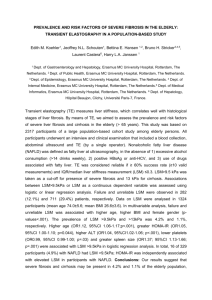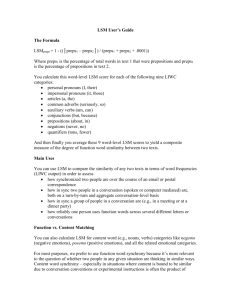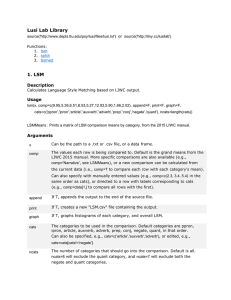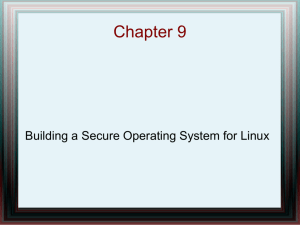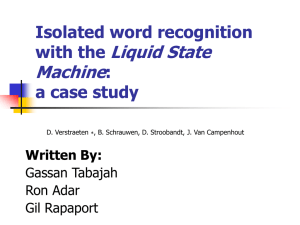Sample presentation - Linear scheduling
advertisement
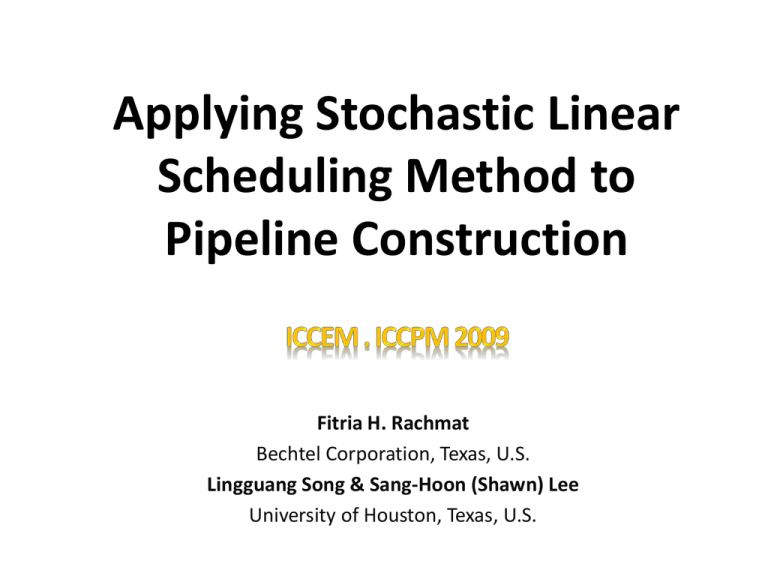
Applying Stochastic Linear Scheduling Method to Pipeline Construction Fitria H. Rachmat Bechtel Corporation, Texas, U.S. Lingguang Song & Sang-Hoon (Shawn) Lee University of Houston, Texas, U.S. Agenda • • • • • Linear Construction Linear Scheduling Method (LSM) Research Problem & Objectives Stochastic LSM (SLSM) Case Study – – – – – Pipeline Construction Data Collection Automated Input Modeling SLSM Modeling Outputs • Conclusions Linear Construction Projects • Characteristics – Involve a large number of repetitive activities – Activities occur in succession – Subject to uncertainty and interruptions – E.g. high-rise, pipeline, and highway projects • Project Success – Effective project scheduling/control – Ensure continuous work flow w/o interruptions Pipeline Construction “Assembly Line” Linear Scheduling Method (LSM) • LSM – – – – • Benefits Designed for linear construction 2D time-space graph Production line = repetitive task Line slope = productivity Location Formwork Floor 2 - 2 – – – – Easily model repetitive tasks Both time & space data Visualize time/space buffers Visualize work continuity Rebar Time Buffer Interruption Space Buffer Floor 2 - 1 July 1 July 2 Electrical Calendar A Demo of LSM Section 2B Pour Section Layout Section 1B Traditional Bar Chart Schedule Schedule Delay - Elimination Floor 2 Formwork Rebar 2B Electrical Concreting 1B LSM Chart Pour section layout Research Problem & Objectives Current Look-ahead Scheduling Practice Historical data Personal experience Deterministic schedule (CPM or LSM) Proposed Look-ahead Scheduling Method • Use real project data Collect actual project data Automated input modeling Stochastic LSM simulation • Include uncertainty • Accurate schedules Stochastic Linear Scheduling Method (SLSM) • Actual productivity data collection • Automated input modeling – Determine distributions of activity productivity • Simulation Modeling – Simulation: a mathematic-logic model of a real world system – A linear project can be modeled using “Project” and “Activity” elements in SLSM • Simulation experiments & outputs A Case Study • Case Study – Construction of ~130 miles of 30” pipeline • Procedure – Data collection – Automated input modeling – Simulation models – Output schedules Data Collection Sample Actual Productivity Data Date Task Station Footage Productivity (ft/d) From To 9/15 Stringing 5484+00 5636+00 15,000 15,000 9/16 Stringing 5636+00 5705+83 6,983 6,983 9/17 Stringing 5705+83 5806+00 10,017 10,017 9/18 Stringing 5806+00 5972+00 16,600 16,600 9/19 Stringing 5972+00 6140+00 16,800 16,800 Automated Input Modeling • Input modeling – Determine the underlying statistical distribution’s of an activity’s productivity rate Automated using BestFit ® Automated Input Modeling Parameters for Fitted Distribution Actual Productivity Data Fitted distribution Input Modeling Outputs Task Name Statistical Distributions Surveying Exponential with mean =16629 Clearing Exponential with mean = 9527 Grading Normal with mean = 2874 and standard deviation = 1363 Trenching Triangular with low limit = 670, most likely = 1809, and high limit = 10720 Stringing Normal with mean = 4837 and standard deviation = 3011 Bending Beta with a = 2.3, b = 3.4, low = 670, and high = 13812 Welding Beta with a = 1.2, b = 1, low = 700, and high = 9800 Lower-in Normal with mean = 5882 and standard deviation = 3033 Tie-in Exponential with mean = 2007 Backfill Beta with a = 1.2, b = 2.9, low = 804, and high = 15758 Clean up Normal with mean = 3688 and standard deviation = 1221 SLSM Modeling • Establish a “Project” element • Determine work scope • Add “Task” elements • Productivity rate • Time & space buffer • Start time Experiment & Outputs Comparison of baseline schedule & simulated look-ahead schedule Experiment & Outputs Uncertainty analysis of project total duration Individual activity performance range Conclusions • Actual project data can be used to enhance look-ahead scheduling accuracy • Automated input modeling makes simulation more accessible to industry practitioners • SLSM successfully incorporates uncertainty in traditional LSM method. Thank You & Questions 19
